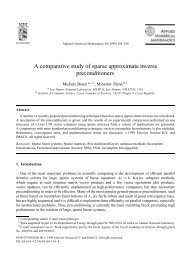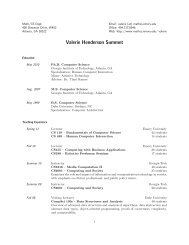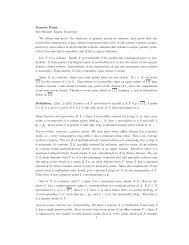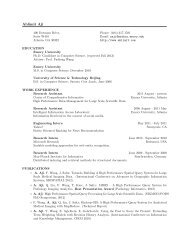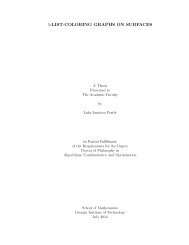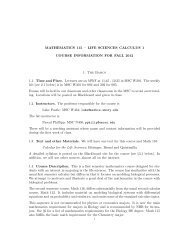Chapter 3 Solution of Linear Systems - Math/CS
Chapter 3 Solution of Linear Systems - Math/CS
Chapter 3 Solution of Linear Systems - Math/CS
You also want an ePaper? Increase the reach of your titles
YUMPU automatically turns print PDFs into web optimized ePapers that Google loves.
62 CHAPTER 3. SOLUTION OF LINEAR SYSTEMS<br />
Here the superscripts on the entries a (k)<br />
ij<br />
are used to indicate entries <strong>of</strong> the matrix that are modified<br />
during the kth elimination step. Recall that, in general, the multipliers are computed as<br />
mij =<br />
element to be eliminated<br />
current pivot element<br />
If the process does not break down (that is, all pivot elements, a11, a (1)<br />
22<br />
the matrix A can be factored as A = LU where<br />
⎡<br />
⎢<br />
L = ⎢<br />
⎣<br />
1<br />
m21<br />
m31<br />
.<br />
0<br />
1<br />
m32<br />
.<br />
0<br />
0<br />
1<br />
· · ·<br />
· · ·<br />
. ..<br />
⎤<br />
0<br />
0 ⎥<br />
0 ⎥<br />
. ⎦<br />
and<br />
⎡<br />
⎢<br />
U = ⎢<br />
⎣<br />
mn1 mn2 mn3 · · · 1<br />
The following example illustrates the process.<br />
Example 3.3.1. Consider the matrix<br />
⎡<br />
A = ⎣<br />
1 2 3<br />
2 −3 2<br />
3 1 −1<br />
Using Gaussian elimination without row interchanges, we obtain<br />
⎡<br />
1<br />
⎣ 2<br />
2<br />
−3<br />
⎤<br />
3<br />
2 ⎦ −→<br />
⎡<br />
1<br />
⎣ 0<br />
2<br />
−7<br />
⎤<br />
3<br />
−4 ⎦ −→<br />
3 1 −1<br />
0 −5 −10<br />
and thus<br />
⎡<br />
L = ⎣<br />
1 0 0<br />
m21 1 0<br />
m31 m32 1<br />
m21 = 2<br />
m31 = 3<br />
3 5<br />
7<br />
⎤<br />
⎦ .<br />
.<br />
, a(2) 33 , . . ., are nonzero) then<br />
upper triangular matrix<br />
after elimination is<br />
completed<br />
⎡<br />
⎣<br />
m32 = 5<br />
7<br />
⎤ ⎡<br />
1 0 0<br />
⎤<br />
⎡<br />
⎦ = ⎣ 2 1 0<br />
1<br />
⎦ and U = ⎣<br />
It is straightforward to verify2 that A = LU; that is,<br />
⎡<br />
1<br />
⎣ 2<br />
2<br />
−3<br />
⎤ ⎡<br />
3 1<br />
2 ⎦ = ⎣ 2<br />
0<br />
1<br />
⎤ ⎡<br />
0<br />
0 ⎦ ⎣<br />
3 1 −1<br />
1<br />
3 5<br />
7<br />
If we can compute the factorization A = LU, then<br />
1 2 3<br />
0 −7 −4<br />
0 0 − 50<br />
7<br />
Ax = b ⇒ LUx = b ⇒ Ly = b, where Ux = y.<br />
Therefore, the following steps can be used to solve Ax = b:<br />
• Compute the factorization A = LU.<br />
• Solve Ly = b using forward substitution.<br />
• Solve Ux = y using backward substitution.<br />
1 2 3<br />
0 −7 −4<br />
0 0 − 50<br />
7<br />
1 2 3<br />
0 −7 −4<br />
0 0 − 50<br />
7<br />
2 Recall from Section 1.2 that if A = LU, then the i, j entry <strong>of</strong> A can be obtained by multiplying the ith row <strong>of</strong> L<br />
times the jth column <strong>of</strong> U.<br />
⎤<br />
⎦ .<br />
⎤<br />
⎦<br />
⎤<br />
⎦ .<br />
⎤<br />
⎥ .<br />
⎥<br />
⎦



